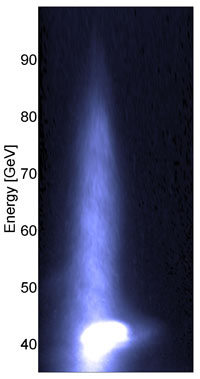

Thursday - February 15, 2007
SLAC Today is
available online at:
http://today.slac.stanford.edu
In this issue:
New Accelerator Technique Doubles Particle Energy in Just One Meter
Science Today: A Universe without Weak Interactions
AAAS Conference Offers Broad View on Science
 |
 |
|
Thursday - February 15, 2007 |

The blue streak in this photograph shows the dramatic gain in energy made by some of the electrons in a bunch after passing through plasma (ionized gas). The white spot shows the electrons in the bunch that generated the plasma to propel the other electrons to double their energy, to 85 billion electron volts (GeV).
New Accelerator Technique Doubles Particle Energy in Just One MeterImagine a car that accelerates from zero to 60 in 250 feet and then rockets to 120 miles per hour in just one more inch. That's essentially what a collaboration of accelerator physicists has accomplished, using electrons for their racecars and plasma for the afterburners. Because electrons already travel at near light's speed in an accelerator, the physicists actually doubled the energy of the electrons, not their speed. The researchers—from the Department of Energy's Stanford Linear Accelerator Center (SLAC), the UCLA Henry Samueli School of Engineering and Applied Science, and the University of Southern California Viterbi School Of Engineering—published their work in the February 15 issue of Nature. This achievement demonstrates a technology that may drive the future of accelerator design. To reach the high energies required to answer the new set of mysteries confronting particle physics—such as dark energy and the origin of mass—the newest accelerators are vastly larger, and consequently more expensive, than their predecessors. Very high-energy particle beams will be needed to detect the very heavy and very short-lived particles that have eluded scientists so far. "We hope that someday these breakthroughs will make future generations of accelerators feasible and affordable," said SLAC Deputy Director Persis Drell. "It's wonderful to see the tremendous progress in understanding the underlying physics for fundamentally new methods of accelerating particles." Read more... |
||
|
|
||
 A Universe without
|
AAAS Conference Offers Broad View on ScienceThe American Association for the Advancement of Science (AAAS) holds its annual meeting this weekend in San Francisco. This event has become one of the most important gatherings of the year for the science media and those interested in the interactions among disciplines and in the influence of science and technology on society. Over 5,000 researchers and journalists are expected to attend the three-day conference. Attendees will have the opportunity to choose among a broad range of activities, including nearly 180 symposia as well as plenary and topical lectures. Several SLAC researchers, including Dr. Burton Richter, will speak at the meeting. Click here for a full conference schedule. The general public is invited to attend Family Science Days, plenary events, career workshops, and the exhibit hall. In addition, a town hall on "Communicating and Learning About Global Climate Change: An Event for Teachers, Students, and Other Communicators and Learners" is intended to expand the dialogue among scientists, teachers, students, policy-makers, business leaders, and the general public on the issue of global climate change. |
Events (see all | submit)
Access (see all)
Announcements
|
| | ||
|
|
||
 <%
Response.AddHeader "Last-modified", getArticleDate()
'Response.AddHeader "Last-modified","Mon, 01 Sep 1997 01:03:33 GMT"
'Monday, December 06, 2010
%>
<%
Response.AddHeader "Last-modified", getArticleDate()
'Response.AddHeader "Last-modified","Mon, 01 Sep 1997 01:03:33 GMT"
'Monday, December 06, 2010
%>View online at http://today.slac.stanford.edu/. |
||